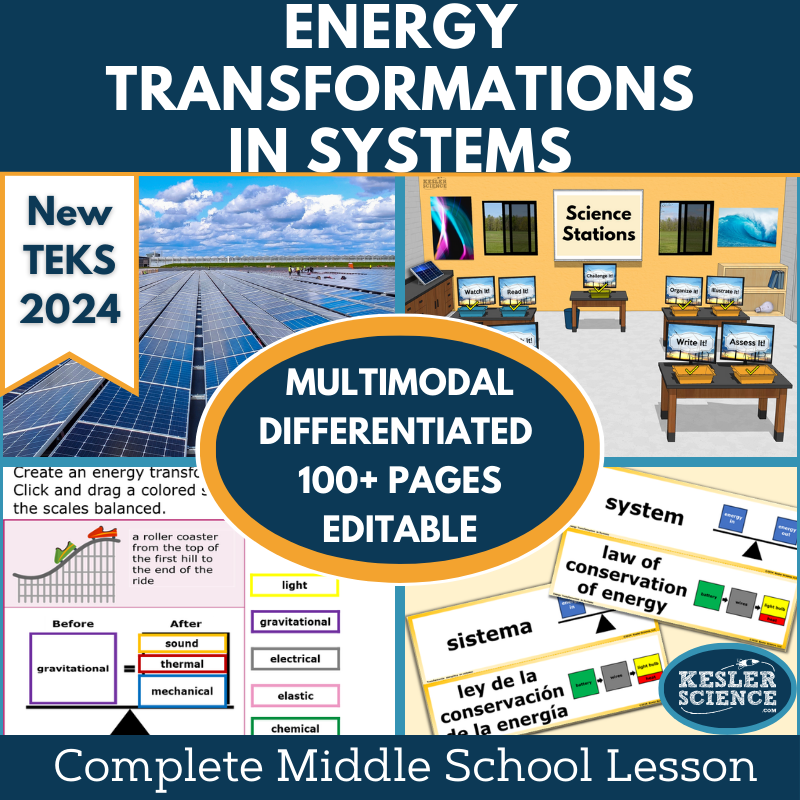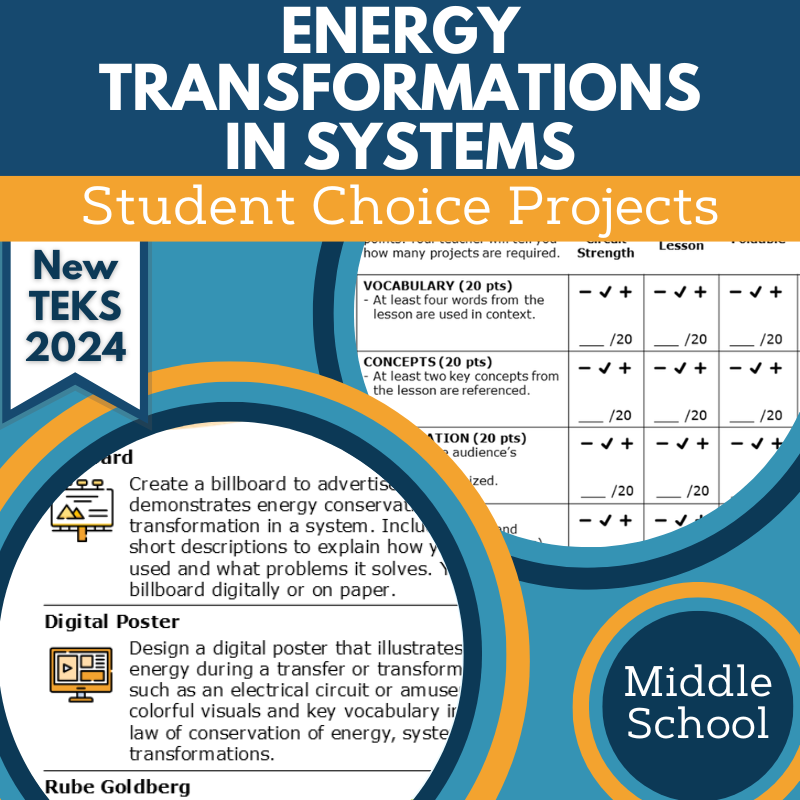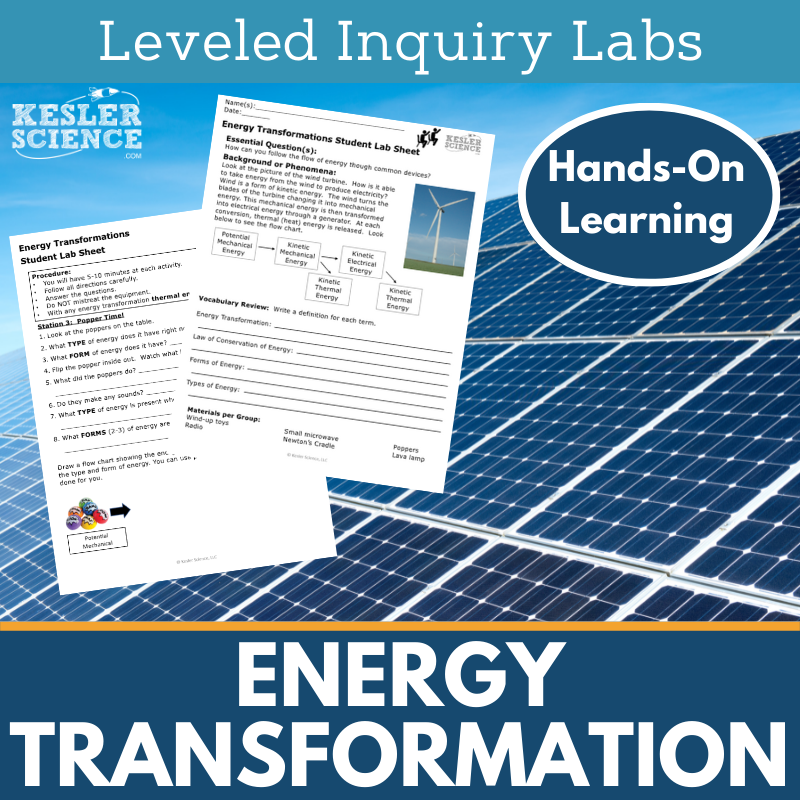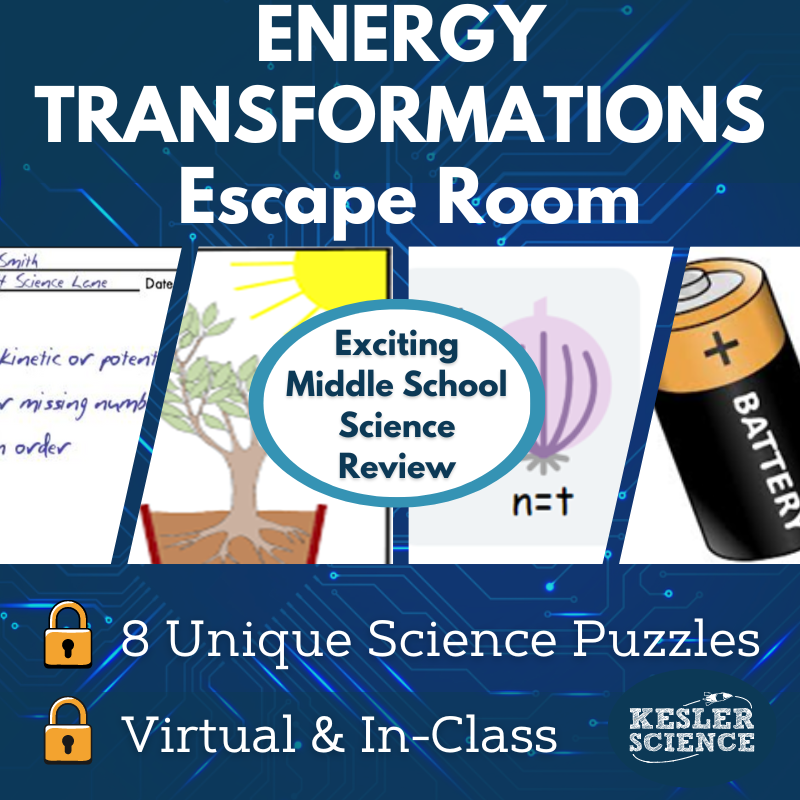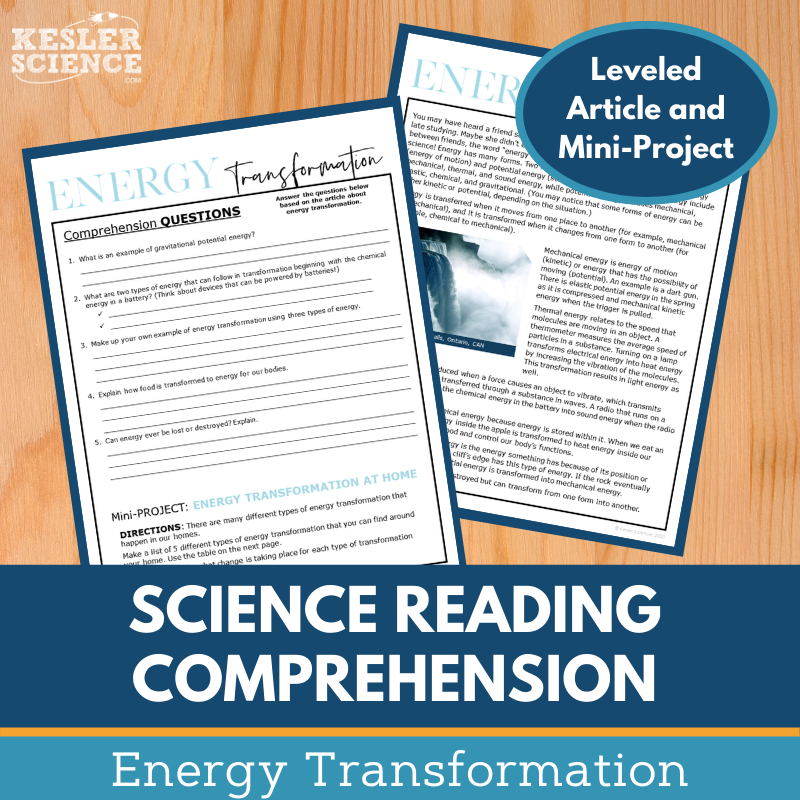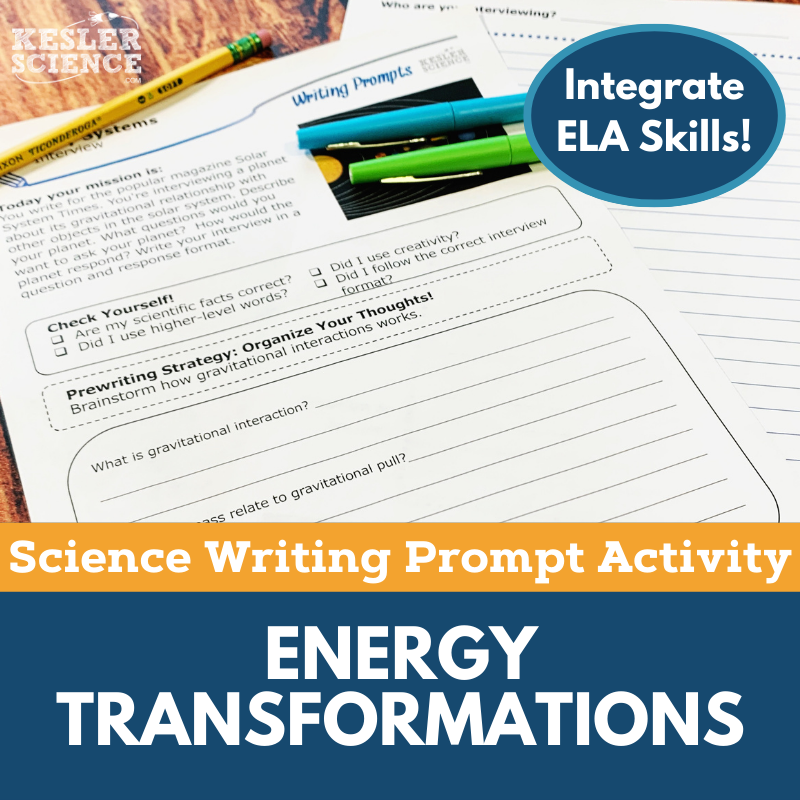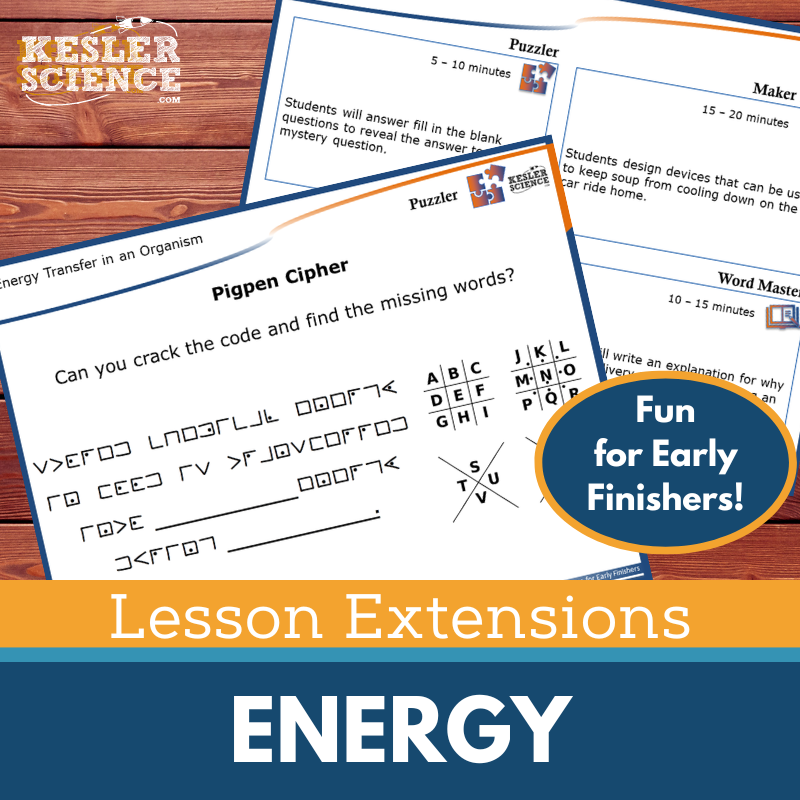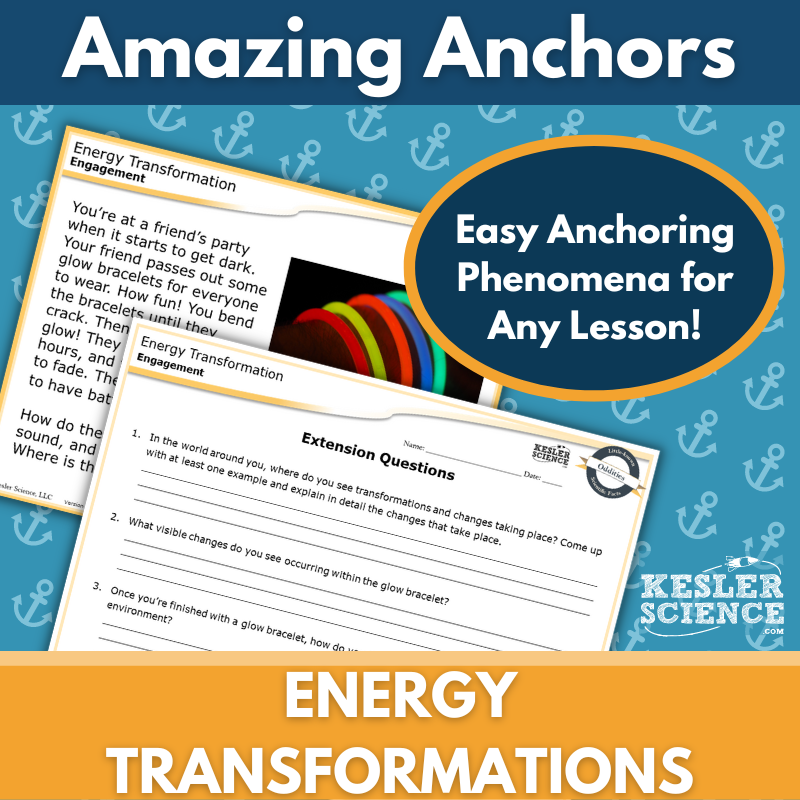Energy Transformations in Systems Activities for Middle School Science
Understanding how energy is conserved through transfers and transformations is essential in science, and this engaging lesson helps middle school students master the concept. The resources below will give students a comprehensive understanding of energy transformations. All of the following materials are also included in the Kesler Science Membership.
The Kesler Science Energy Transformations in Systems 5E Lesson is a comprehensive middle school unit on how energy is conserved through transfers and transformations in systems like electrical circuits, food webs, amusement park rides, and photosynthesis. It includes editable presentations, worksheets, assessments, and student-choice projects, requiring minimal prep for differentiated, student-led learning.
Students will explore energy conservation through an engaging, multimodal station lab with input stations for hands-on activities, reading passages in English and Spanish, research tasks, and videos, as well as output stations for categorization, writing, illustration, and assessment. A bonus challenge station extends learning for early finishers. Explanation resources include editable PowerPoints, interactive notebooks, and note-taking templates. Elaboration activities allow students to apply their understanding through choice projects, while STAAR 2.0-aligned assessments and review worksheets support evaluation.
This lesson is carefully aligned with the 2021 TEKS 6.8B standard and offers flexible print and digital formats, including Spanish translations. Designed for in-class or virtual learning, it follows the 5E Model—Engagement, Exploration, Explanation, Elaboration, and Evaluation—to ensure a thorough understanding of energy conservation.
The Kesler Science Energy Transformations in Systems 5E Lesson is a comprehensive middle school unit on how energy is conserved through transfers and transformations in systems like electrical circuits, food webs, amusement park rides, and photosynthesis. It includes editable presentations, worksheets, assessments, and student-choice projects, requiring minimal prep for differentiated, student-led learning.
Students will explore energy conservation through an engaging, multimodal station lab with input stations for hands-on activities, reading passages in English and Spanish, research tasks, and videos, as well as output stations for categorization, writing, illustration, and assessment. A bonus challenge station extends learning for early finishers. Explanation resources include editable PowerPoints, interactive notebooks, and note-taking templates. Elaboration activities allow students to apply their understanding through choice projects, while STAAR 2.0-aligned assessments and review worksheets support evaluation.
This lesson is carefully aligned with the 2021 TEKS 6.8B standard and offers flexible print and digital formats, including Spanish translations. Designed for in-class or virtual learning, it follows the 5E Model—Engagement, Exploration, Explanation, Elaboration, and Evaluation—to ensure a thorough understanding of energy conservation.
Engage your middle school students with this student-led station lab on energy transformation in systems, aligned with the 2021 TEKS 6.8B standard. Designed for in-class or virtual learning, this interactive lesson guides students as they explore how energy is conserved through transfers and transformations in systems like electrical circuits, food webs, amusement park rides, and photosynthesis.
Students direct their own learning through nine differentiated stations that include hands-on activities, readings, videos, research, and assessments. They will manipulate images, organize information, illustrate models, write responses, and complete tasks that reinforce their understanding. English and Spanish reading passages support differentiated instruction, and a bonus challenge station provides extension activities for advanced learners.
This low-prep, high-engagement resource fosters critical thinking and active learning while allowing teachers to facilitate rather than direct instruction.
Engage your middle school students with this student-led station lab on energy transformation in systems, aligned with the 2021 TEKS 6.8B standard. Designed for in-class or virtual learning, this interactive lesson guides students as they explore how energy is conserved through transfers and transformations in systems like electrical circuits, food webs, amusement park rides, and photosynthesis.
Students direct their own learning through nine differentiated stations that include hands-on activities, readings, videos, research, and assessments. They will manipulate images, organize information, illustrate models, write responses, and complete tasks that reinforce their understanding. English and Spanish reading passages support differentiated instruction, and a bonus challenge station provides extension activities for advanced learners.
This low-prep, high-engagement resource fosters critical thinking and active learning while allowing teachers to facilitate rather than direct instruction.
The Energy Transformations in Systems Student Choice Projects align with the 2021 TEKS standard 6.8B, allowing middle school students to select a project that matches their preferred output style. A project page outlines six student-led options plus a “design your own” project, all with an editable rubric for teacher, peer, or self-assessment.
These flexible, multimodal projects offer creative ways for students to demonstrate their understanding. Two versions of the project page support differentiation, with modified options for students needing remediation and challenge options for advanced learners. Teachers can adjust the rubric to fit grading needs.
The projects require standard classroom supplies like paper, markers, and scissors, with many options available for digital completion.
The Energy Transformations in Systems Student Choice Projects align with the 2021 TEKS standard 6.8B, allowing middle school students to select a project that matches their preferred output style. A project page outlines six student-led options plus a “design your own” project, all with an editable rubric for teacher, peer, or self-assessment.
These flexible, multimodal projects offer creative ways for students to demonstrate their understanding. Two versions of the project page support differentiation, with modified options for students needing remediation and challenge options for advanced learners. Teachers can adjust the rubric to fit grading needs.
The projects require standard classroom supplies like paper, markers, and scissors, with many options available for digital completion.
This TEKS-aligned Energy Transformations Inquiry Lab helps students demonstrate energy transformations, such as how energy in a flashlight battery changes from chemical to electrical to light energy. Students will explore energy transformations using household objects through six optional station labs.
This resource includes three differentiated labs to support diverse learning needs. The Dependent Student Lab provides guided instructions and inquiry questions for on-level learners. The Modified Student Lab offers a structured experience with sentence stems and multiple-choice questions for students needing modifications. The Independent Student Lab is student-driven, requiring learners to make decisions and conduct the lab with minimal guidance.
Teacher resource pages include prep instructions, standards, objectives, materials lists, and additional resources. Editable reflection questions guide students through claim, evidence, and reasoning statements. Answer keys are provided for easy grading.
Materials needed per group include wind-up toys, an electric radio, poppers, a small microwave, a beaker, cold water, a flashlight with batteries, and a glow stick or bracelet. This hands-on lab provides an engaging way for students to explore energy transformations.
This TEKS-aligned Energy Transformations Inquiry Lab helps students demonstrate energy transformations, such as how energy in a flashlight battery changes from chemical to electrical to light energy. Students will explore energy transformations using household objects through six optional station labs.
This resource includes three differentiated labs to support diverse learning needs. The Dependent Student Lab provides guided instructions and inquiry questions for on-level learners. The Modified Student Lab offers a structured experience with sentence stems and multiple-choice questions for students needing modifications. The Independent Student Lab is student-driven, requiring learners to make decisions and conduct the lab with minimal guidance.
Teacher resource pages include prep instructions, standards, objectives, materials lists, and additional resources. Editable reflection questions guide students through claim, evidence, and reasoning statements. Answer keys are provided for easy grading.
Materials needed per group include wind-up toys, an electric radio, poppers, a small microwave, a beaker, cold water, a flashlight with batteries, and a glow stick or bracelet. This hands-on lab provides an engaging way for students to explore energy transformations.
The Energy Transformations Escape Room is an engaging, student-centered activity that reinforces how energy changes from one form to another, aligning with TEKS and NGSS standards. Through interactive challenges, students explore energy transformations, such as chemical energy in a battery converting to electrical and light energy.
Teachers have full control over the eight independent puzzles, allowing customization for different class lengths. The escape room can be set up using simple materials like manila envelopes or an authentic lock-and-box setup. Digital versions are available for individual student use through PowerPoint or Google Slides, with printable formats for home learning.
The resource includes teacher directions, answer keys, a digital answer sheet, editable templates, a video challenge, and engaging props. Students will enjoy solving puzzles while deepening their understanding of energy transformations in this immersive learning experience.
The Energy Transformations Escape Room is an engaging, student-centered activity that reinforces how energy changes from one form to another, aligning with TEKS and NGSS standards. Through interactive challenges, students explore energy transformations, such as chemical energy in a battery converting to electrical and light energy.
Teachers have full control over the eight independent puzzles, allowing customization for different class lengths. The escape room can be set up using simple materials like manila envelopes or an authentic lock-and-box setup. Digital versions are available for individual student use through PowerPoint or Google Slides, with printable formats for home learning.
The resource includes teacher directions, answer keys, a digital answer sheet, editable templates, a video challenge, and engaging props. Students will enjoy solving puzzles while deepening their understanding of energy transformations in this immersive learning experience.
This Energy Transformation Science Reading Comprehension Lesson helps students explore how energy changes from one form to another through a nonfiction article, comprehension questions, and a real-world application activity. Designed for grades 6-8, with higher-level 5th graders in mind, the leveled passage supports science literacy and reading comprehension.
The resource includes two leveled articles (Lexile 1100-1300), five to seven comprehension questions, and a hands-on mini-project where students identify energy transformations in a home. A Cornell notes template is provided for structured note-taking.
Suitable for in-person and virtual learning, the resource is compatible with Google Classroom, MS Teams, Schoology, and Canvas, allowing students to respond digitally. Perfect for sub plans, extra credit, ISS, or whole-class instruction, this engaging lesson fosters critical thinking, classroom discussions, and textual analysis while reinforcing key energy transformation concepts.
This Energy Transformation Science Reading Comprehension Lesson helps students explore how energy changes from one form to another through a nonfiction article, comprehension questions, and a real-world application activity. Designed for grades 6-8, with higher-level 5th graders in mind, the leveled passage supports science literacy and reading comprehension.
The resource includes two leveled articles (Lexile 1100-1300), five to seven comprehension questions, and a hands-on mini-project where students identify energy transformations in a home. A Cornell notes template is provided for structured note-taking.
Suitable for in-person and virtual learning, the resource is compatible with Google Classroom, MS Teams, Schoology, and Canvas, allowing students to respond digitally. Perfect for sub plans, extra credit, ISS, or whole-class instruction, this engaging lesson fosters critical thinking, classroom discussions, and textual analysis while reinforcing key energy transformation concepts.
The Energy Transformations Science Writing Prompt Activity engages middle school students in a creative, song-based writing exercise to reinforce their understanding of energy transformations. Aligned with TEKS, this low-prep, student-centered activity helps students demonstrate how energy changes forms, such as chemical energy in a flashlight battery transforming into electrical and light energy. Designed for both in-person and virtual learning, this resource fosters science reasoning and exploration while enhancing writing skills.
This activity includes teacher directions with an answer guide, project ideas, and rubrics. It offers both full-sized and half-sheet handouts with the writing prompt, self-check tools, and pre-writing strategies. A projection version allows for easy classroom display, while a digital PowerPoint version supports Google Slides for remote learners. Ideal for cross-curricular activities, formative assessments, student choice projects, early finisher tasks, extra credit, make-up work, TELPAS samples, and differentiation, this writing prompt makes a valuable addition to any science classroom. It can also be displayed on bulletin boards or compiled into a student anthology. Since this activity is designed for review, it assumes students have prior knowledge of the topic or access to research materials.
The Energy Transformations Science Writing Prompt Activity engages middle school students in a creative, song-based writing exercise to reinforce their understanding of energy transformations. Aligned with TEKS, this low-prep, student-centered activity helps students demonstrate how energy changes forms, such as chemical energy in a flashlight battery transforming into electrical and light energy. Designed for both in-person and virtual learning, this resource fosters science reasoning and exploration while enhancing writing skills.
This activity includes teacher directions with an answer guide, project ideas, and rubrics. It offers both full-sized and half-sheet handouts with the writing prompt, self-check tools, and pre-writing strategies. A projection version allows for easy classroom display, while a digital PowerPoint version supports Google Slides for remote learners. Ideal for cross-curricular activities, formative assessments, student choice projects, early finisher tasks, extra credit, make-up work, TELPAS samples, and differentiation, this writing prompt makes a valuable addition to any science classroom. It can also be displayed on bulletin boards or compiled into a student anthology. Since this activity is designed for review, it assumes students have prior knowledge of the topic or access to research materials.
The WIKI Tickets© Energy Set provides 18 formative assessments for 6th-8th grade science, offering flexible ways to check student understanding. Each topic includes five format options: a full-screen projection version, three printable handouts (full, split, and quarter-page sizes), and an interactive digital version available as an editable PowerPoint or Google Slides file.
Aligned with NGSS and TEKS standards, these assessments cover key energy-related topics such as energy transformations, heat transfer, kinetic and potential energy, wave characteristics, and photosynthesis. Some topics include multiple tickets, ensuring comprehensive coverage, and a table of contents file is included for easy alignment reference.
Designed for both in-person and virtual learning, WIKI Tickets© can be used as exit tickets, bellringers, or quick checks. Students can write responses on their own paper when projected or complete digital versions in a 1:1 or remote setting. These engaging assessments help you gauge student progress with ease.
The WIKI Tickets© Energy Set provides 18 formative assessments for 6th-8th grade science, offering flexible ways to check student understanding. Each topic includes five format options: a full-screen projection version, three printable handouts (full, split, and quarter-page sizes), and an interactive digital version available as an editable PowerPoint or Google Slides file.
Aligned with NGSS and TEKS standards, these assessments cover key energy-related topics such as energy transformations, heat transfer, kinetic and potential energy, wave characteristics, and photosynthesis. Some topics include multiple tickets, ensuring comprehensive coverage, and a table of contents file is included for easy alignment reference.
Designed for both in-person and virtual learning, WIKI Tickets© can be used as exit tickets, bellringers, or quick checks. Students can write responses on their own paper when projected or complete digital versions in a 1:1 or remote setting. These engaging assessments help you gauge student progress with ease.
Lesson Extensions provide engaging, student-choice activities designed to challenge early finishers and deepen their understanding of energy concepts. These activities help reinforce critical thinking, creativity, and problem-solving while keeping students engaged in rigorous yet enjoyable learning opportunities. They are ideal for lesson wrap-ups, enrichment, or filling downtime during testing.
Each extension includes four interactive components: Puzzler for problem-solving, Maker Space for hands-on STEAM activities, Tech Connection for digital media demonstrations, and Word Master for creative writing. Teacher directions, answer keys, and both print and projection versions ensure easy implementation.
Aligned to NGSS and TEKS energy standards, these extensions cover topics such as energy transformations, kinetic and potential energy, thermal energy transfer, the electromagnetic spectrum, and photosynthesis. They provide high-level, independent learning opportunities to help students explore energy concepts in greater depth.
Lesson Extensions provide engaging, student-choice activities designed to challenge early finishers and deepen their understanding of energy concepts. These activities help reinforce critical thinking, creativity, and problem-solving while keeping students engaged in rigorous yet enjoyable learning opportunities. They are ideal for lesson wrap-ups, enrichment, or filling downtime during testing.
Each extension includes four interactive components: Puzzler for problem-solving, Maker Space for hands-on STEAM activities, Tech Connection for digital media demonstrations, and Word Master for creative writing. Teacher directions, answer keys, and both print and projection versions ensure easy implementation.
Aligned to NGSS and TEKS energy standards, these extensions cover topics such as energy transformations, kinetic and potential energy, thermal energy transfer, the electromagnetic spectrum, and photosynthesis. They provide high-level, independent learning opportunities to help students explore energy concepts in greater depth.
This Amazing Anchors Phenomenon Lesson introduces the transfer of energy through the real-world example of Usain Bolt. It begins with an engaging reading on Bolt, followed by comprehension and extension questions to prepare students for deeper learning. A second reading explains the science behind energy transfer in racing, with additional reinforcement questions to extend understanding.
Aligned with TEKS standards, this no-prep resource includes teacher directions, answer keys, projection slides, and both print and digital formats for Google Classroom and other LMS platforms. A differentiated version with sentence starters supports student comprehension. Designed to bookend a lesson, these readings serve as effective supplements in any classroom setting.
This Amazing Anchors Phenomenon Lesson introduces the transfer of energy through the real-world example of Usain Bolt. It begins with an engaging reading on Bolt, followed by comprehension and extension questions to prepare students for deeper learning. A second reading explains the science behind energy transfer in racing, with additional reinforcement questions to extend understanding.
Aligned with TEKS standards, this no-prep resource includes teacher directions, answer keys, projection slides, and both print and digital formats for Google Classroom and other LMS platforms. A differentiated version with sentence starters supports student comprehension. Designed to bookend a lesson, these readings serve as effective supplements in any classroom setting.
Year-Round Resources
These year-round activities will increase your students' understanding of many middle school science topics. All of these activities are also included in the Kesler Science Membership.
Visual Data & Graphing
You're not alone if your students struggle with understanding graphs, charts, and tables. It's a skill that takes an enormous amount of practice. This resource will help students build a strong foundation in analyzing data and creating their own data visualizations.
Bell Ringers and Warm-Ups
These middle school science bell ringers are an excellent way to engage your students as soon as they walk into your classroom. This comprehensive FULL YEAR resource includes everything you need to start off each science class with an interesting warm-up activity.
Review Board Games
Each game board has been carefully designed to keep students engaged. There are 10 different action spaces on each board and dozens of question cards. All of the actions are related to science concepts and keep the students motivated throughout the game.
Each game is ready to play. Simply print out the board and the cards and let the students enjoy reviewing nine different units.
Essential Questions and Standards
Below are the essential questions and standards associated with the lessons and activities included in the atoms unit. This topic is only one of more than 100 middle school science topics included in the Kesler Science Membership.
-
How is energy conserved during transfers and transformations?
-
TEKS Science - 6.8B Energy Transformations in Systems
Kesler Science Membership
Imagine never having to search for another middle school science lesson again. The membership gives you access to ALL of the Kesler Science products in one place (Yes, including everything above).
Say goodbye to long hours of lesson prep.

